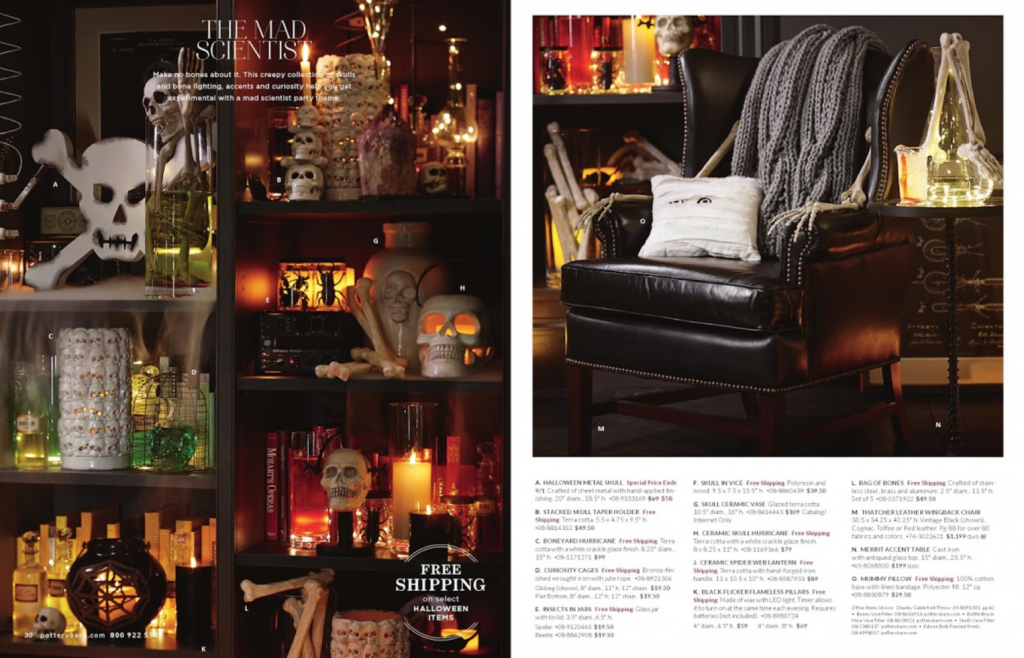 While in London, I had a chance to catch up with Trevor Davis. Davis is one of the people responsible for the IBM Social Sentiment Index and the prediction in January of 2013 that we should expect Steampunk to move from its status as a niche enthusiasm to something more mainstream.
While in London, I had a chance to catch up with Trevor Davis. Davis is one of the people responsible for the IBM Social Sentiment Index and the prediction in January of 2013 that we should expect Steampunk to move from its status as a niche enthusiasm to something more mainstream.
IBM offered its prediction in a wonderful graphic. (Click on the image to get a larger view.)
I came home from 3 weeks in London to find a Pottery Barn catalogue waiting for me.
Here, I thought, was just the place you might expect to find a steam punk reference…whatever other cultural trends might come swimming into view. I began to read.
The results were vexing in the way this kind of work is so often vexing. There was both no evidence and some evidence of steampunk in the Pottery Barn catalog.
No, there is no explict reference verbal or visual. No helmet made of leather, studs, and brass fittings. No science fiction weaponry as if designed by a Victorian. No elaborate time pieces that somehow look to be, mysteriously, steam operated. No glasses that look like something lifted from a 19th century optometrist. There was nothing obviously, unmistakably out of the Steampunk design handbook.
And that’s a pity. These catalogs, stemming perhaps from the brilliant early work by Stephen Gordon for his Restoration Hardware catalogs, now have range they didn’t have in the Sears Roebuck days. The contemporary catalog lets in lots of things in addition to the product. Things are staged beautifully and with great care. So it’s not inconceivable for a Pottery Barn to include a Steampunk helmet or watch for illustrative, evocative, purposes.
Still the fact that there is no explicit reference to Steampunk is NOT evidence that there is no Steampunk influence. I think you can see it in the color pallet, in the mad scientist theme, in the laboratory. As follows:
In point of fact, something happens to trends as they move from the margin to the mainstream. They are obliged to give up some of their defining features. This is a little like the social climber who is obliged to give up some of her friends if she wants to rise. To include a Steampunk helmet would mean quoting an aspect of the trend that is too strange and wonderful for the average American household (at least the kind who shop at Pottery Barn). (If I may voice a note of skepticism against this argument, there is something pretty strange about the skulls. The American household is perhaps less timid than we think.)
This necessary “gearing down” of the trend is the reason that early adopters often disdain the trend as it enters the mainstream. Clearly, it’s been diminished or “dumbed down.” Or to put this another way, the trend must give up some of its extreme characteristics to find a larger audience. In a word, it must be dedorkified. (In effect, this reverses the work of the enthusiastic early adopters / inventors who delight in dorkifying the trend in the first place. I think we can probably agree that the whole issue of dorkification deserves more careful study.)
Trends are Diderot packs. They are a bundle of ideas, aesthetics, materials, colors, shapes, motifs. Not all of these are welcome on the voyage from margin to mainstream. Some will move on. Others will fall behind. And this may help explain why the signature pieces of the Steampunk look are not in evidence by the Pottery Barn catalog. Indeed, the absence of these things are exactly what we would expect of Steampunk in this new context. In sum, the absence of proof is, in a sense, proof of proof. As it were.
So now we have a problem. The most defining design signatures, the ones we can used as proof of a trend’s diffusion, are, in some cases, the very things that will be “edited out” by the diffusion process. It’s not that the Steampunk influence is not there in the Pottery Barn catalog. But there can be no influence unless it is in a sense rendered invisible.
All of this suggests we need a more robust methodology for identifying a trend in motion. Perhaps some combination of colors, shapes, objects, with a statistical feeling for how far from random is the presence of certain elements especially in certain combinations. This tool might enable us to say that our intuitive feeling that the Pottery Barn catalog is in places “pretty Steampunkish” has foundation…because the copresence of these colors, objects and shapes is precisely x far from random. Naturally we would to examine all the Pottery Barn catalogs and see if we can show when the trend enters the catalogs and whether this corresponds to what we know about the development of the trend itself.
Trends have internal dynamics. We also know that whether and how fast they move through the social world depends on a set of diffusion dynamics that we are relatively good at thinking about. (My own modest contribution can be found here.)
But our work as students of the trend is not complete until we create a model of all the trends, and all the decisive economic, historical, social, demographic, technical, digital, and other factors that make up the context in which the trend flourish (or fail).
So was IBM right? Is the planet called Steampunk exercising a tidal pull on the oceans of contemporary culture? Reader, you decide.






